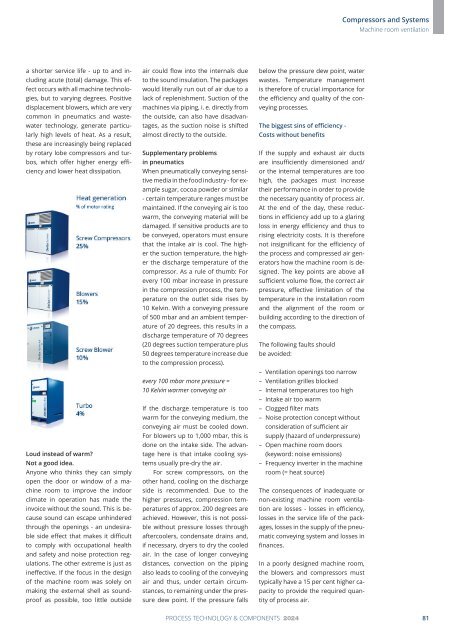PuK - Process Technology & Components 2024
A technical trade magazine with a history of more than 60 years.
A technical trade magazine with a history of more than 60 years.
Create successful ePaper yourself
Turn your PDF publications into a flip-book with our unique Google optimized e-Paper software.
Compressors and Systems<br />
Machine room ventilation<br />
a shorter service life - up to and including<br />
acute (total) damage. This effect<br />
occurs with all machine technologies,<br />
but to varying degrees. Positive<br />
displacement blowers, which are very<br />
common in pneumatics and wastewater<br />
technology, generate particularly<br />
high levels of heat. As a result,<br />
these are increasingly being replaced<br />
by rotary lobe compressors and turbos,<br />
which offer higher energy efficiency<br />
and lower heat dissipation.<br />
Loud instead of warm?<br />
Not a good idea.<br />
Anyone who thinks they can simply<br />
open the door or window of a machine<br />
room to improve the indoor<br />
climate in operation has made the<br />
invoice without the sound. This is because<br />
sound can escape unhindered<br />
through the openings - an undesirable<br />
side effect that makes it difficult<br />
to comply with occupational health<br />
and safety and noise protection regulations.<br />
The other extreme is just as<br />
ineffective. If the focus in the design<br />
of the machine room was solely on<br />
making the external shell as soundproof<br />
as possible, too little outside<br />
air could flow into the internals due<br />
to the sound insulation. The packages<br />
would literally run out of air due to a<br />
lack of replenishment. Suction of the<br />
machines via piping, i. e. directly from<br />
the outside, can also have disadvantages,<br />
as the suction noise is shifted<br />
almost directly to the outside.<br />
Supplementary problems<br />
in pneumatics<br />
When pneumatically conveying sensitive<br />
media in the food industry - for example<br />
sugar, cocoa powder or similar<br />
- certain temperature ranges must be<br />
maintained. If the conveying air is too<br />
warm, the conveying material will be<br />
damaged. If sensitive products are to<br />
be conveyed, operators must ensure<br />
that the intake air is cool. The higher<br />
the suction temperature, the higher<br />
the discharge temperature of the<br />
compressor. As a rule of thumb: For<br />
every 100 mbar increase in pressure<br />
in the compression process, the temperature<br />
on the outlet side rises by<br />
10 Kelvin. With a conveying pressure<br />
of 500 mbar and an ambient temperature<br />
of 20 degrees, this results in a<br />
discharge temperature of 70 degrees<br />
(20 degrees suction temperature plus<br />
50 degrees temperature increase due<br />
to the compression process).<br />
every 100 mbar more pressure =<br />
10 Kelvin warmer conveying air<br />
If the discharge temperature is too<br />
warm for the conveying medium, the<br />
conveying air must be cooled down.<br />
For blowers up to 1,000 mbar, this is<br />
done on the intake side. The advantage<br />
here is that intake cooling systems<br />
usually pre-dry the air.<br />
For screw compressors, on the<br />
other hand, cooling on the discharge<br />
side is recommended. Due to the<br />
higher pressures, compression temperatures<br />
of approx. 200 degrees are<br />
achieved. However, this is not possible<br />
without pressure losses through<br />
aftercoolers, condensate drains and,<br />
if necessary, dryers to dry the cooled<br />
air. In the case of longer conveying<br />
distances, convection on the piping<br />
also leads to cooling of the conveying<br />
air and thus, under certain circumstances,<br />
to remaining under the pressure<br />
dew point. If the pressure falls<br />
below the pressure dew point, water<br />
wastes. Temperature management<br />
is therefore of crucial importance for<br />
the efficiency and quality of the conveying<br />
processes.<br />
The biggest sins of efficiency -<br />
Costs without benefits<br />
If the supply and exhaust air ducts<br />
are insufficiently dimensioned and/<br />
or the internal temperatures are too<br />
high, the packages must increase<br />
their performance in order to provide<br />
the necessary quantity of process air.<br />
At the end of the day, these reductions<br />
in efficiency add up to a glaring<br />
loss in energy efficiency and thus to<br />
rising electricity costs. It is therefore<br />
not insignificant for the efficiency of<br />
the process and compressed air generators<br />
how the machine room is designed.<br />
The key points are above all<br />
sufficient volume flow, the correct air<br />
pressure, effective limitation of the<br />
temperature in the installation room<br />
and the alignment of the room or<br />
building according to the direction of<br />
the compass.<br />
The following faults should<br />
be avoided:<br />
– Ventilation openings too narrow<br />
– Ventilation grilles blocked<br />
– Internal temperatures too high<br />
– Intake air too warm<br />
– Clogged filter mats<br />
– Noise protection concept without<br />
consideration of sufficient air<br />
supply (hazard of underpressure)<br />
– Open machine room doors<br />
(keyword: noise emissions)<br />
– Frequency inverter in the machine<br />
room (= heat source)<br />
The consequences of inadequate or<br />
non-existing machine room ventilation<br />
are losses - losses in efficiency,<br />
losses in the service life of the packages,<br />
losses in the supply of the pneumatic<br />
conveying system and losses in<br />
finances.<br />
In a poorly designed machine room,<br />
the blowers and compressors must<br />
typically have a 15 per cent higher capacity<br />
to provide the required quantity<br />
of process air.<br />
PROCESS TECHNOLOGY & COMPONENTS <strong>2024</strong><br />
81

















